City Trip Lisbon
Lisbon is a city to look down on
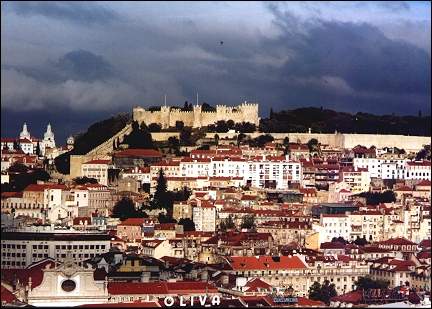
|
Lisbon is very much aware of its own beauty. In every high lying place you find a miradouro with a great view of the city. And there is much to see. Moreover, Lisbon has a lively nightlife with restaurants, cafés and extraordinary old coffeehouses.
Travelogue & photos: Piet de Geus
To the left the Ponte de 25 Abril spans the Tagus, benath an enormous statue of Christ (the little brother of the one in Rio), which seems to spread its arms to another monstrosity, the Discoveries Memorial in Belém on the other shore. Underneath the bridge we see in the distance the Torre de Belém. We are quickly approaching Lisbon's city center: downtown, with on the hill to its left Bairro Alto and on the hill to its right the Alfama with the cathedral, the bright white dome of Santa Engrácia and the white marble São Vicente de Fora. High above the Alfama tower the walls of Castelo São Jorge.
After our trip in the Alentejo we put our bikes on the hydrofoil in Montijo and now we're almost flying over the Tagus to the center of Lisbon. It's a wonderful way to enter the city and it also saves us a boat tour of the harbor. After forty minutes the ferry docks near the Estação Fluvial, next to the Praça de Comércio.
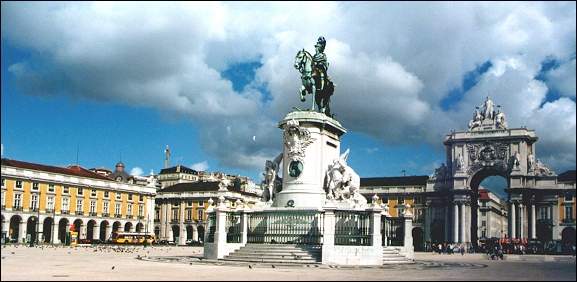
A little later we walk on this huge and beautiful square, which is surrounded by white-yellow government buildings with cool arches. The popular name for the square still is Terreiro de Paça, terrace of the palace. Before most of Lisbon was destroyed by an earthquake in 1755, King Manuel's palace was here. Only the stairs along the Tagus still remind of the palace. One can't deny the inhabitants of Lisbon a sense of history - then again this is the city of nostalgia and longing.
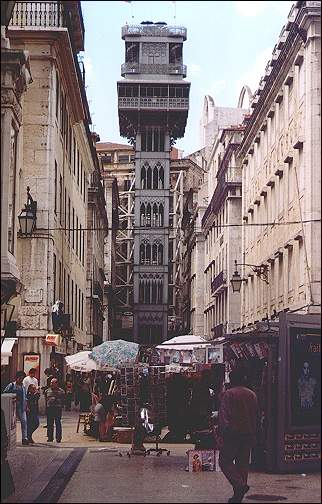
|
In the center of Praça de Comércio sits a huge equestrian statue of King José I, who ruled during the reconstruction of Lisbon after the earthquake. An enormous triumphal arch is the entrance to Baixa, downtown Lisbon. It's not just the Arco da Victório that reminds us of Paris, the same goes for all of Baixa with its grid pattern of streets and Neo-Classical buildings, but most of all the wide Avenida de Liberdade. In Rua de Santa Justa moreover, is a huge metal construction that has unmistakably been designed by a student of Eiffel: the Elevador de Santa Justa, which takes you up from the Baixa to a platform, from where you walk into Chiado over a pedestrian bridge. No need to mention that here you have a great view.
We also want to go up to the Chiado and from there to the Bairro Alto to find a place to stay. Staying in this lively entertainment district has the advantage of getting home quickly at night. But we cannot use the elevator with two bicycles. So we push them through steep streets, avoiding the many with stairs. We're lucky and soon we find a Bed & Breakfast in a quiet corner of the neighborhood, between Praça Louis de Camões and Largo Trinidade Coelho.
We don't even have to leave our street for a Fado restaurant. That's really convenient, because after we have showered and dressed, it is already late. Just around the corner, in the Travessa da Espera, we enter a restaurant that I remember from earlier visits to Lisbon: Canto do Camões. Even though there are more tourists than the other times, the atmosphere is still pleasant. And the Fado is still good, the performers are well-known singers. About the food, the vast wine list and the service we have no complaints, either. So we just sit back and let the evening happen, while it gets later and later.
Castelo São Jorge and Santa Cruz
All over town historical districts are being renovated
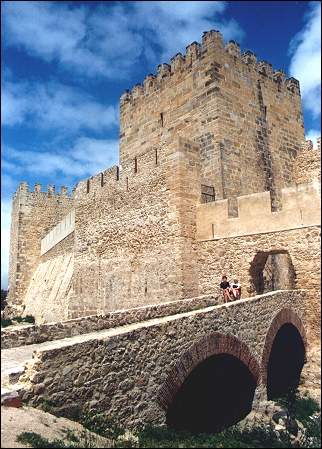
|
Amidst the pigeons on Largo Trinidade Coelho a drunk man is quarreling with a bronze statue. From this square we descend series upon series of stairs and end up, via the Rossio Station on the busy Rossio Square. Officially it's called Praça Dom Pedro IV, but nobody uses that name. It's definitely not a remarkable square, there's a lot of traffic and on the sidewalks shoe shiners sit between the many beggars. Of course sunglasses and hashies are also offered for sale.
Around Rossio Square are some atmospheric old cafés, coffeehouses, pastry shops and restaurants. We have coffee and cake in Suiça, known for its pastry. We leave the coffeehouse on the other side and find ourselves on the Praça da Figueira, a large rectangular square, where you'll find more renowned businesses around the marble fountain
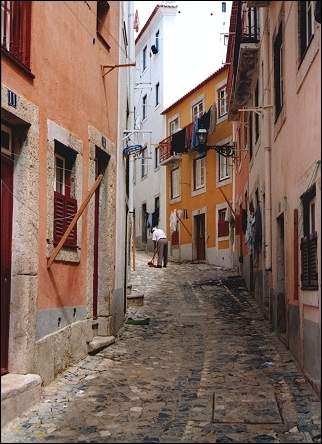
|
From Praça da Figueira we ascend through endless stepped streets to the Mouraria and then further up to Castelo São Jorge. Through a gate in the outermost wall of the castle we reach the streets of the medieval neighborhood Santa Cruz. Here and there are still scaffolds, but most of the buildings have already been renovated. All over Lisbon historical parts of the city are being renovated: Mouraria, Chiado, Bairro Alto and Alfama. The work on the Praça de Comércio and Santa Cruz has been completed. Despite these efforts Lisbon looks dirtier and more dilapidated than we remember. Even in downtown we saw slums and everything is seriously affected by the large amount of traffic. But Santa Cruz looks spick and span again with its in pastel colors painted houses behind the inevitable laundry.
The Castelo itself also underwent a rigorous renovation and looks as if it has been built yesterday. Which is partly true: in the 1980's it was mostly ruins. Now there's a complete castle, with lots of towers and galleries. The castle is surrounded by a park with terraces and paths.
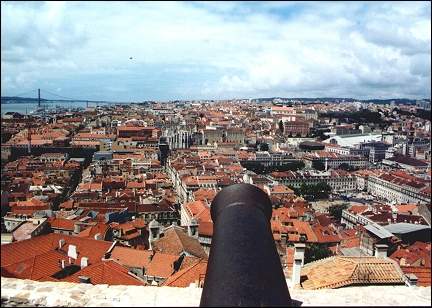
|
The view from Miradouro São Jorge on the castle walls is as beautiful as ever. Over the barrels of old cannons you can see the Tagus and all of the city center.
Lisbon is a city to look out on while you let your thoughts wander, that's why there are miradouros everywhere. Walk up in any direction and you'll eventually find one of those lookouts. It doesn't matter whether it's day or night, the view is always great.
We have dinner in style in the Rua do Alecrim in Chiado, at Brasserie de l'Entrecôte. We are accompanied to a table in the atmospheric, long rectangular dining hall with ceilings at least 15 feet (5 m) high. We're asked how we'd like our entrecote, because this restaurant is true to its name and serves only one main course. As an appetizer we have a delicious salad with nut dressing. With our main course, which is served with an excellent cilantro sauce, we drink a nice bottle of Dão.
Alfama
Everywhere are diminutive shops, bars and restaurants
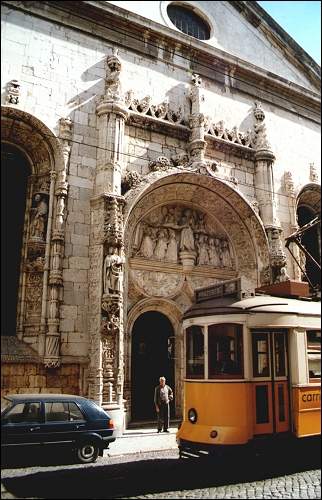
|
Today we walk in the direction of Castelo as well, but this time Alfama, on a steep hill between the castle and the Tagus, is our goal. We walk down from Bairro Alto through Rua Garret in Chiado, where we have breakfast at A Brasileira, the most famous coffeehouse of the city. The interior hasn't changed in a century. Outside, on the terrace, sits the poet Pessoa, a regular, cast in bronze.
If you don't want to walk all the way up from downtown, Lisbon has a wide choice in original means of transportation. Except for the already mentioned Elevador de Santa Justa, there are funiculars, which are also called 'elevador'. But also the ordinary trams take the hills without any problems, even though they squeak and moan. These trams date from the early 20th century and have become museum pieces themselves. They define the look of Lisbon.
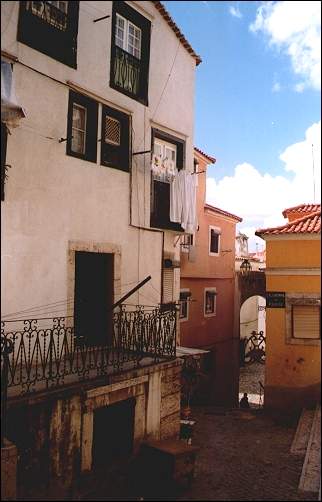
|
The sun is shining and we take a detour via the Praça de Comércio, to look at the Tagus. We pass by the Conceição Velha church, which has an exuberant Manuelan portal. Over a square with palm trees, around which are high buildings with beautiful azulejos, we start climbing towards Alfama. At the entrance of Alfama is the Sé, Lisbon's cathedral, with two fortress-like towers as eye catchers. And that's all there is, the interior is bare and dilapidated. The same goes for the cloister with in its center the not very spectacular unearthed remains of the mosque on top of which the cathedral was built.
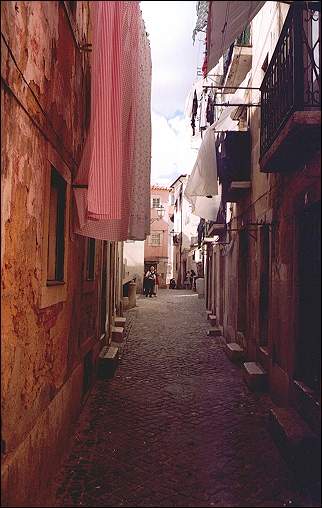
|
Via countless steps and gates we climb in rather random directions higher and higher toward Alfama. Around São Miguel market stalls with vegetables and fruit fill the narrow alleys. Everywhere in Alfama are diminutive shops, bars and restaurants. The central thought is: if you have a space that is wide enough for a frontdoor, there is enough room to open a café, restaurant or pastelaria.
From Miradouro Santa Luzia, a park with a pergola, built on top of a wall dating from the Moorish era, you have a fine view of the Tagus.
To the left, on the next hill the dome of Santa Engrácia is visible above a maze of red tiled roofs. A little higher is São Vicente de Fora, a huge, dazzling white marble structure with two towers.
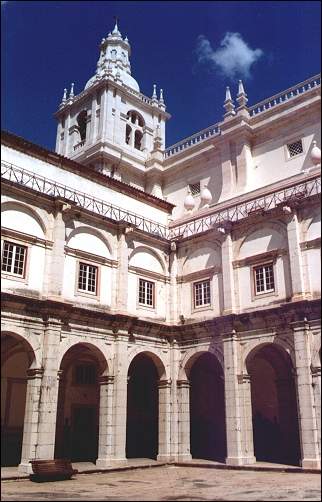
|
The church itself is not all that special, but the monastery next to it is. The gorgeous cloister is decorated with exceptionally pretty azulejo panels, one of which show the conquest of Lisbon by the Moors and others show the fables of La Fontaine. Around the cloister are some interesting halls, of which the refectory functions as a mausoleum for the kings of the Bragança dynasty. Via countless stairs you can go all the way up to the roof and walk between the towers. It's getting tedious, but from here you have a great view of the city and the Tagus.
Through the gate next to São Vicente de Fora, we reach the Feira de Ladra, the Saturday open-air market. The merchandise is clothes, shoes, cassettes and cd's, sunglasses, trinkets, army dump stuff, so-called antiques and assorted junk. The market ends at the Santa Engrácia. This church is in the Guinness Book of Records because its construction lasted longer than that of any other church: it started in the 17th century and only in 1966 the last work on the dome was completed. The church is a mausoleum for Portuguese Great Men. If you need another view of the city and the harbor, you can take the elevator upstairs.
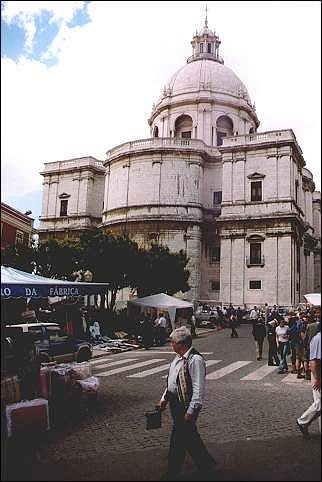
|
We have enjoyed the view enough for now and descend into downtown to stroll along the stylish stores in Baixa-Chiado. In Rua Aurea is a store that sells only music by Amália Rodrigues; her beautiful voice sounds over the street all day long. A little further is Casa Chineza, again one of those wonderful old coffeehouses. Of course they serve all kinds of pastries and sweets, but they also have delicious fresh fruit juices.
On Avenida da Liberdade are some places to spend a few hours. In the little park behind the roundabout are greenhouses with splashing waterfalls between the lush green of the plants. And nearby the Praça Alegria is the Jardim Botânico, a late 19th century botanical garden with big palm trees and plants from all over the world.
Belém
Center of Manuelean architecture on the Tagus
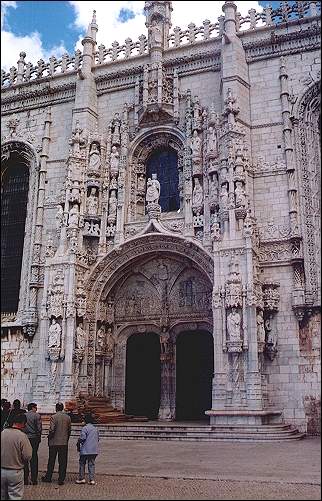
|
Belém is an atmospheric old suburb with a lot of places of interest. In its main street is Antiga Confeitaria de Belém, a gorgeous old coffeehouse with a maze of rooms with azulejos. The original pasteis de Belém are served fresh from the oven here.
Vasco da Gama left Belém in 1497 on an expedition of discovery. After Da Gama discovered a sea route to the East, King Manuel built a huge monastery, partly from the revenue of the spices that where brought from the East: the Jerónimos monastery. It's without a doubt one of the most impressive constructions in Portugal. It was built in the style that is named after king Manuel and which is characterized by lavish decoration with motives from the shipping trade and the newly discovered worlds.
The attention-getter of the monastery is the huge Eastern portal, lavishly decorated with a relief that shows Henry the Seaman and a group of people, surrounded by decorative motives. Both in the decoration style of the big convent church and in the slim columns one can recognize Eastern influences. This architectural tour de force even managed to survive the great earthquake.
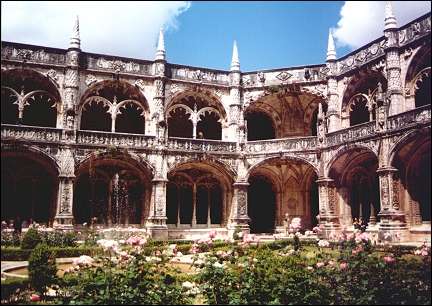
|
And the church is only a foretaste of what you get to see when you enter the double cloister. It is truly unimaginable: over two storeys the most fantastic decorations snake around the patio.
It's as if the windows are covered with lace. The decorations are so incredibly refined. All this extravaganza is kept together and balanced by the Gothic basic structure. If that weren't the case, one would get dizzy from all this waving and turning movement.
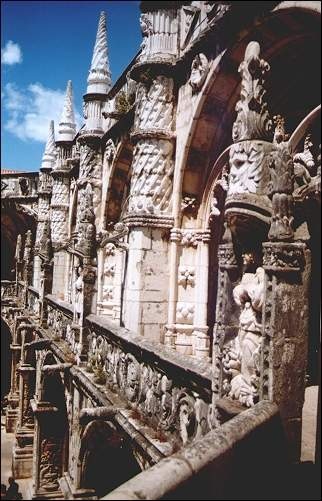
|
In the West wing of the monastery is, very aptly, a maritime museum. It shows the history of the Portuguese shipping trade, from the early discoveries to this century. The museum has a large collection of old maps, ship models, armours, cannons and colonial objects. There are even complete ships and fully furnished royal saloons, including crockery.
On the quay is the Torre de Belém, another extravagantly decorated construction. This tower, five floors high, was used in the defense of the harbor. Thanks to its decorations and Moorish battlements it looks remarkably elegant for a defence with thick walls.
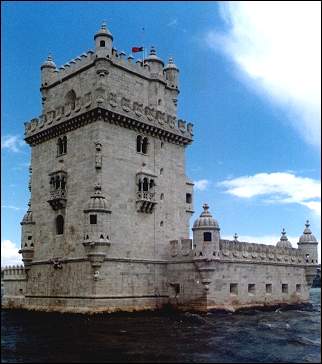
|
Originally the Torre de Belém was in the water of the harbor (the Jerónimos monastery was directly on the water), but because deposit formed over the centuries it now is only surrounded by water on three sides. No need to say that the tower is a miradouro from which you have an astonishing view of Lisbon and the harbor. This goes also for the nearby 150 feet (50 m) high Memorial of the Discoveries, which has the added advantage that if you're standing on it, you don't have to see the monstrosity itself.
Bairro Alto
At night the neighborhood awakes
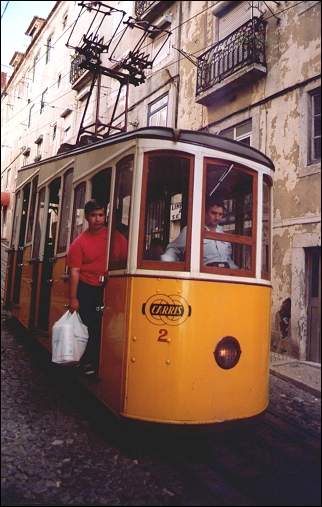
|
From the Cais do Sodré Station we take the Elevador da Bica back to Bairro Alto. Via Praça Louis de Camões, with its characteristic mosaic of black and white stones, we wander through the neighborhood along high buildings with azulejos. As a matter of course we end up in Solar do Vinho do Porto, the city palace owned by the institute that monitors the quality of port wines. Slumped in an easy chair in quiet surroundings you can take your time tasting some of the hundreds of different kinds of port wine that are on the wine list.
When we're done tasting, Bairro Alto, which is relatively quiet in the daytime, is awake. Every night the same pattern unfolds. First the tourists come and have dinner in one of the many second tier Fado restaurants. Everywhere you hear the unavoidable Uma Casa Portugesa, which has the same status as Zorba's Dance in Greece. Through the open doors one everywhere sees the same abuse: idiots in shorts clapping with the music, sometimes even performing silly dances and probably thinking that what they're hearing has something to do with Fado. That was probably what they were told when they were dropped here.
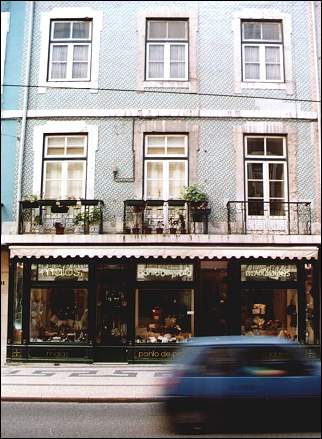
|
After the bus loads have left, the Portuguese arrive, in droves they move from bar to nightclub and back. It's elbow to elbow in the narrow streets and alleys. We let ourselves drift with the flow and end up in a bar in Rua da Atalaia, where the waiters are clearly gym-frequenting gay men. Yes, also the gay nightlife takes place in Bairro Alto. The music is an odd mix of disco and Fado, the clientele is extremely mixed and the atmosphere relaxed.
It's getting time for dinner. We end up in Adega do Ribatejo, a Fado restaurant recommended by the Portuguese writer Rentes de Carvalho. Outside, in front of the entrance, a drunk singer stands - his face looks familiar. It turns out that it is Ruiz Castro, who was portrayed in the Fado documentary A Song of Grief.
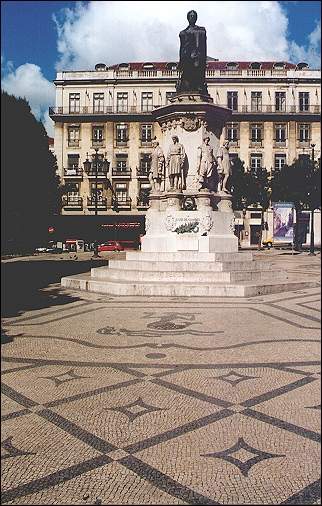
|
The obligatory songs are performed dutifully, without a break. The female cook also sings a song. Her singing is as unremarkable as her cooking. On the other hand, it's a nice and cozy mess, with staff members teasing each other. No waiter can pass by without kicking the guitarist's leg out of the way (and in his turn be grabbed by the throat by the blind singer), ties are constantly being pulled out of position... anyway, the kind of humor that the Portuguese never can get enough of.
After most of the guests have left, the character of the evening changes. The singers and musicians now play for themselves and all slickness has disappeared. They encourage and teach each other new songs. An old female Fado singer teaches a young male colleague to sing with passion and change back and forth from heartrending screaming to whispering. The atmosphere is great, so we order another drink.
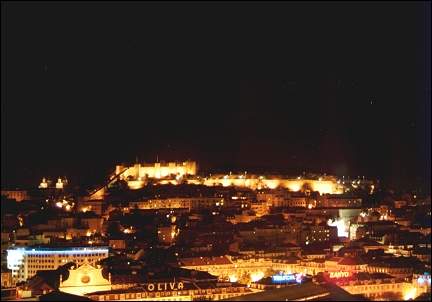
|
It is night when we enter the park, next to the Elevador da Glória, where Miradouro S. Pedro de Alcântara sits on top of a wall covered with a waterfall of blossoming Bougainvillea.
Beneath us the lights of Rossio square shine, on the other side of the valley the illuminated walls of Castelo São Jorge. While we're gazing at the city we think about the last couple of days. There is so much we haven't seen: whole neighborhoods, interesting museums, cities nearby with beautiful palaces and parks, the beach... yes, we definitely have to come back.